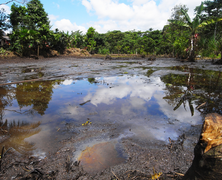
How we treat the natural world often mirrors how we
treat each other. Across the globe, we are injuring ecosystems and people by
treating the natural world as property to feed our economic system. Both
government and non-government entities are harassing, threatening, attacking,
imprisoning and even killing defenders of environmental and human rights. In
fact, the United Nations found that human rights defenders working on
“land and environmental issues in connection with extractive industries and
construction and development projects in the Americas” faced the highest risk
of death of all human rights advocates worldwide.
J. Gomba, Lagio Agrio Oil Field, Ecuador
These continued violations of
fundamental rights must stop. We must hold our governments and
industry accountable for actions that impact human and environmental
well-being. We can do this by: reformulating our laws to implement
environmental rights, bolstering monitoring and enforcement of human and
environmental rights violations, and beginning to shift to ecological
economics models that
respect people and planet. Earth Law Center has started these efforts with
actions such as advocacy before the United Nations to recognize “nature’s rule of
law” in UN sustainability discussions.
The number of overlapping human and
environmental rights violations is rising, and we must recognize as many as we
can. Earth Law Center is mapping such co-violations and concerns so that we can
act together for change. You can start
now by joining us and Amnesty International in support
of Fundacion Pachamama’s work to expose such violations in Ecuador. Also, weigh in in support of 130 First Nations in
Canada against the proposed Enbridge Northern Gateway Pipeline,
which would link the massive Alberta tar sands project with the ecologically
rich and sensitive British Columbia coast.
Please contact
us to recommend
additions and updates to this map, and please share this page widely!
The United
Nations Universal Declaration of Human Rights asserts
an inherent “right to life, liberty and security of person.” Modeled on this
Declaration, the Universal Declaration of the Rights of Mother Earth was
adopted by the 35,000 attendees (from 140 nations) at the World People’s
Congress on Climate Change and the Rights of Mother Earth and formally presented to the UN. It recognizes the “right
to life and to exist” of “Mother Earth and all beings of which she is
composed.” Like our own inherent value, the value and rights of nature do
not arise from human decisions on nature’s worth, but from its existence on
this planet.
The United Nations Declaration on the Rights of Indigenous
Peoples, recognizes that “indigenous peoples have the right to
self-determination,” and that “free, prior and informed consent” is required in
the face of potential infringements to such rights. Indigenous communities in
particular often face situations in which violations of their rights and
environmental rights co-arise. One example is the Marlin Mining
Project, where killings, other violence and environmental
devastation related to gold mining are destroying a long-established Mayan
community.
* To visit the map,
click here.